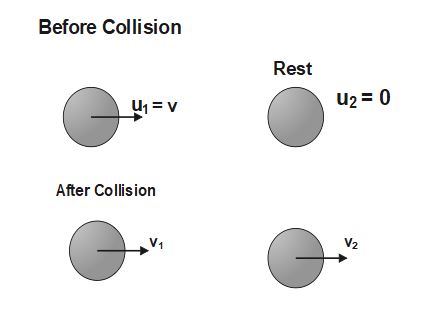Head on collision : Important case of partial elastic collision
Q.A ball of mass m moving at a speed v makes a head on collision with an identical ball at rest. If the kinetic energy of the balls after collision is \frac34th of the original. Then the coefficient of restitution is
(A) e=\frac1{\sqrt2}
(B) e=\frac12
(C) e=\frac{\sqrt2}3
(D) e=\frac13
Solution
Key concepts to solve the following problem:
- Head-on collision
- Coefficient of restitution
- Conservation of linear momentum
Given that, mass of each ball = m
According to law of conservation of momentum
m_1 u_1 +m_2 u_2 = m_1 v_1 + m_2 v_2
m v +m *0 = m v_1 + m v_2
m v = m (v_1 + v_2)
v = (v_1 + v_2)
v_1 + v_2 = v.....(1)
Given that , K.E._{net,f\;}=\frac34K.E._{net,i\;}
Therefore, \frac12\;m_1\;v_1^2\;+\;\frac12\;m_2\;v_2^2\;=\;\frac34\left[\frac12\;m_1\;u_1^2\;+\;\frac12\;m_2\;u_2^2\;\right]
\frac12\;m\;\left(\frac{v(1-e)}2\right)^2\;+\;\frac12\;m\;\left(\frac{v(1+e)}2\right)^2\;=\;\frac34\left[\frac12\;m\;v^2\;+\;\frac12\;m\;{\ast\;0}^2\;\right]
\frac12\;\;\frac{v^2\;\left(1+e\right)^2}4\;+\;\frac12\;\;\frac{v^2\;\left(1-e\right)^2}4\;=\;\frac34\left(\frac12\;v^2\;\right)
\Rightarrow\left(1+e\right)^2+\left(1-e\right)^2=3
\Rightarrow1+\;e^2+\;2e\;+\;1\;+\;e^2-2e\;= 3
\Rightarrow\;2\;e^2=\;1
\Rightarrow\;e^2=\;\frac12
\Rightarrow\;e=\;\frac1{\sqrt2}
(A) is correct option

The formula of coefficient of restitution is :
e=\;\frac{vel. of sepration}{vel. of approach}
e=\;\frac{v_2-v_1}{u_1-u_2}
e=\;\frac{v_2-v_1}{v-0}
v_2- v_1= ev ....(2)
On adding (1) and (2), we get
2 v_2 = v +ev
v_2=\;\frac{v(1+e)}2
On subtracting (2) from (1), we get
2 v_1 = v - ev
v_1=\;\frac{v(1-e)}2
Before jumping into the concept of head-on collisions partial elastic collision, we have to grasp a basic understanding of lines of impact and motion. Secondly, the knowledge of coefficient of restitution is of equal importance.
Line of Impact: The line along which the colliding objects make contact during the collision.
Line of Motion: The line along which the objects are moving.
Collisions can be classified into two main types based on the orientation of the line of impact and the line of motion of the colliding objects. These types are:
Head on Collision :
- In a head on collision, the line of impact is along the line of motion of the colliding objects. The objects approach each other directly, and the impact occurs along the same straight line. This type of collision is often analyzed in the context of one-dimensional motion for simplicity.
Oblique Collision :
- In an oblique collision, the line of impact is not aligned with the line of motion of the colliding objects. The objects approach each other at an angle, resulting in an impact that is not directly along the line of motion. Oblique collisions are more complex to analyze compared to head-on collisions, as they involve vector components and require consideration of two-dimensional motion.
The coefficient of restitution (e) is a crucial factor in understanding the nature of a collision. It is defined as the ratio of the final relative velocity of separation to the initial relative velocity of approach. Mathematically, e is expressed as:
e=\;\frac{relative\;velocity\;of\;separation}{relative\;velocity\;of\;appraoch\;}The coefficient of restitution can take values between 0 and 1, inclusively, where:
e=0 represents a perfectly inelastic collision, where the colliding objects stick together after the collision. Here, the loss in net Kinetic energy is maximum after collision. And It is not necessary that there is always a complete loss of kinetic energy
0<e<1 denotes a partially elastic collision, where some of kinetic energy is lost.
e=1 signifies a perfectly elastic collision, where the colliding objects bounce off each other without any loss of kinetic energy.
Conclusion:
Problem solving becomes easy if we have basic knowledge of types of collisions. Understanding the coefficient of restitution is crucial in analyzing the nature of collisions and predicting the post-collision velocities of the objects involved. Except for perfectly inelastic collisions, the colliding objects get separated after the collision, undergoing either some loss or no loss in net kinetic energy, depending on the nature of the collision. Moreover, the law of conservation is applicable in all types of collisions, whether elastic, inelastic, or partially elastic
